How Weather Affects Arthritis: Myth or Fact?
2025-10-16 Arthritis usually makes people conscious of their joints. If you have arthritis, you may have noticed that certain types of weather seem to increase the aches in your joints. Perhaps your knees freeze up when it is cold, or your fingers are achy when it is raining. Is this real, or simply an old wives' tale? Does the weather really make arthritis worse? Let's break down the facts versus the fables, and explore some strategies for managing the pain of arthritis in the seasons, winter in particular. To start, a brief refresher. Arthritis is a condition characterized by inflammation of one or more joints. And, there are more than 100 types of arthritis, but the most common types of arthritis include: Osteoarthritis (OA): wear-and-tear of cartilage. Rheumatoid Arthritis (RA): an autoinflammatory condition. Psoriatic Arthritis: related to psoriasis. Gout: due to uric acid crystals. In general, common symptoms include pain, stiffness, swelling, and decreased mobility. Related: What is Arthritis? Types, Symptoms, Causes, and Treatment Myth or Fact? Many people with arthritis report that their symptoms worsen with changing weather. And this sentiment is not new--considered even centuries ago! Even Hippocrates, the Ancient Greek physician, noted it! But what does science say? The truth is that there is no easy answer. Some studies show a relationship between weather and joint pain while others show no relationship at all. That said, many doctors do feel the weather can affect joint pain, even if we do not quite know how that influence is exerted. The primary weather factors that appear to be relevant: Cold Weather: Many people indicate increased arthritis pain in the winter months. Why? Cold makes your muscles tense up, which can create stiffness in your joints. The barriers to blood flow in cold weather can lead to increased pain. People are generally less active in winter, which will lead to stiffness and a loss of muscle control. For some, even a modest dip in temperature could be a harbinger of joint pain. Humidity Humidity (the amount of moisture in the air) can also be problematic. Why Moist air can lead to WEIGHT in your joints. Moisture combined with storms or rain will bring a drop in Barometric Pressure, which can affect how your joints feel. Barometric Pressure Barometric pressure is simply the weight of air in the atmosphere, which is influenced by the weather. Why When the dynamic state of the weather changes, so does the Barometric Pressure above your body. Barometric pressure drops immediately before a storm or rain. With this pressure drop, the tissue around your body expands, stressing your joints. Therefore, people with arthritis may feel this is pain, swelling, or stiffness. Rainy Weather While rain doesn't cause arthritis, pressure and humidity changes that occur before the storm may trigger arthritis. That’s why many people say, “I can feel the rain in my bones.” Hot Weather Some people actually feel worse when it's hot and humid. Heat may tire a person out more, especially in RA. Why People with arthritis can also experience increased swelling due to water retention in hot weather. Winter Joint Pain: Why Is It Worse? Winter is often the toughest time of year for many people living with arthritis due to a variety of factors. Here are just a few: Cold air can cause muscles and joints to tighten Less sunlight means less vitamin D, which is important for bones and joints People are less active, causing more stiffness Gaining weight in winter strains your joints even more. If you're troubled by arthritis pain during the chilly or rainy seasons, here are a few quick strategies that might help you cope in those times: Keep Warm Dress in layers. Use hot packs or warm compresses on painful joints. Take warm showers or baths to relax your muscles. Stay Active Light exercise, such as walking, yoga, and swimming, can keep your joints moving. Stretch regularly, especially in the mornings. Don't push too hard; consider your body. Stay Hydrated Your body still needs water in cold weather. If you are dehydrated, it can make your joints feel worse. Eat Joint-Friendly Food Omega-3 fatty acids (found in fish) help reduce inflammation. Watch your sugar spikes and fast foods that can aggravate your flare-ups. Keeping your Vitamin D levels up is important; ask your doctor about taking supplements. Get Enough Sleep When you sleep, your body is repairing itself, which can help reduce inflammation. Consider a weighted blanket for warmth and comfort. Use a Supportive Device If you have arthritis in your hands, consider wearing gloves. Consider using a brace or wrap on your knees, wrists, or ankles if needed. Consider using arthritis-friendly tools to help reduce the impact your joints must endure. If your joint pain: Suddenly gets worse, lasts several days without any sign of relief, and stops you from engaging in your daily function, … it’s time to ask your doctor. You may require a new medication, physical therapy, or additional diagnostic tests. No way. If your joints hurt more when it’s cold, wet, or raining, you are not crazy. While researchers may still be debating the exact reasons, many people believe there is a connection between the weather with arthritis. What is more important is knowing how your body reacts to the weather and how to help control your pain. The weather is bad enough, but you don’t have to let the care of your arthritis be dictated by it if you take care of yourself. Weather may not cause arthritis, but it can worsen the symptoms. Understanding your triggers helps you take better control.What Is Arthritis?
Is There a Link Between Weather and Arthritis?

How Does Weather Affect Arthritis?

What Can You Do? Winter Joint Pain Relief Tips
Read Also: Living with Arthritis: Tips to Manage Pain Daily
When Should You See a Doctor?

Check Out: Top 5 Benefits of Choosing L&B Clinic for Your Arthritis Treatment
Conclusion:
Quick Summary
Remember:
Stay warm, stay active, and don’t hesitate to seek help.
.png)















